| |
"Stylistically, Endless Night feels indebted in no small way to the work of Alfred Hitchcock, with whom of course Gilliat and Herrmann had worked; Herrmann's score evokes Vertigo, as does a dream sequence where Bennett sees Mills, only with her face blank and featureless, while Ekland is a more corporeal manifestation of the 'other woman'." |
| |
James Gent, wearecult.rocks* |
Despite author Agatha Christie's novel output being synonymous with 'whodunits', Endless Night is more of a 'who's-going-to-do-it' and 'when-and-what-are-they-going-to-do?' That's to say, as long as you go in cold, you'll have some fun figuring things out. I'm not going to take it as anything like a sign that one of the film's actors George Sanders killed himself before the movie came out (how's that for film criticism?) It was director Sidney Gilliat's last film, a name more connected to writing Hitchcock thrillers in my narrow view of film history. Endless Night is a title taken from William Blake's poem Auguries of Innocence and it beats me what significance it has to the novel or plot. But it's a great poem with hazily remembered lines from other sources. Three pages of Google searches couldn't help jog my memory as to why some of these lines are so well known. "To hold infinity in the palm of your hand and eternity in an hour…" I'm sure someone must have recorded those lines for a song or something. Yes, I came up with Sting but that's not where I know the lines from so well…
So, it's the early 70s. A languid voice over introduces us to a beautiful view and a beautiful girl – well, if she had a face I'm sure she'd be beautiful. Cue a scream and two men are walking through what seems like a garden, their lower legs only visible, the gravel crunch of footsteps starting a recurring sound theme, noticeable as such only after repeated viewings. Mike is telling (his neighbour, his doctor?) his story… Flashback: Mike Rogers is a drifter who's currently employed as a chauffeur. He lives somewhat dangerously bidding high on beloved works of art he definitely can't afford. On a job in Rome, he meets an architect who's taken with Mike's pie-in-the-sky ideas about owning a house with one of the best views in England at a Devonshire location known as Gipsy's Acre. Michael is eventually fired for insubordination and visiting his dream location to take pictures to send to the architect, he meets Ellie who dances into his camera frame dressed all in white. At first she flips off her shoes and starts to move, unaware he's there. They strike up a conversation and Mike puts forward all his detailed ideas about the place and what he might do if he had the resources. They are interrupted by the obligatory strange, local woman. (I mean, who puts cats on leads?) Miss Townsend is spiritually inclined and mad as a box of frogs. Despite the amphibious connection, you can't help thinking she's actually a bit of a red herring as she talks about there being a curse on the decrepit old ruin of a house. A romance blossoms but as Ellie is stupendously rich, people are suspicious of the romance and eventual wedding. The dream house gets built and then things start to go seriously pear shaped.
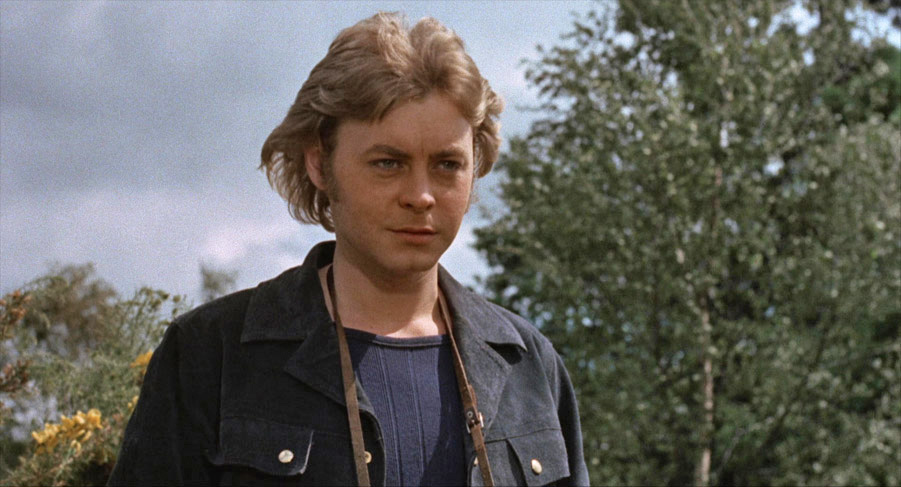
It's a fine cast with Hywel Bennett as Mike who never opened the door to his film career as wide as I suspect he might have liked. Boyish and handsome with twinkling blue eyes, he may have been too slight as leading man material but he was an interesting actor playing an aimless layabout very much like the TV role he's best known for, Shelly. In late career he was often cast as a criminal but as a young man, he was perfect for the idealistic dreamer who woos and romances his way into significant amounts of money. Bennett starred in a few films with Hayley Mills in the 60s. Mills got her break as a child actress at Disney after her performance in Tiger Bay opened up an international career at all of 12 years of age. She even earned herself an Oscar. In Endless Night, Mills is Ellie, the petite, blonde rich girl trying hard to gain some life experience outside the cushioning and insulating effects of great walls of cash. Mike is her passport to those experiences. Mills plays Ellie effortlessly (it's not such a stretch from actress to character) except her American accent is somewhat inconsistent.
Early James Bond's Miss Moneypenny herself, Lois Maxwell is a cynical aunt who scowls at Mike as her way of introduction. To The Manor Born's Peter Bowles plays her husband. It's always a joy seeing the über-suave Bowles on the big screen as familiar as we are with him on TV. Windsor Davies as a police sergeant is also a lovely inclusion in just a few brief scenes. While he made the loud, theatrical Sergeant Major Williams a British icon in the 70s in the woke-averse sit-com It Ain't Half Hot, Mum, his earthy baritone also played over many commercials of the period. George Sanders is the lawyer trying to protect the family but he also harbours an avuncular respect for Mike when he realises that it may be love and not a scam to get cash from the family in return for a quiet divorce. The mysterious Greta, like Harry Lime in The Third Man, is mentioned throughout as a malign force and as played by Britt Ekland, she is eventually introduced on screen over halfway through the film. She seems to be unfairly characterised. Or is she? But the real surprise, performance wise is the dying architect, Santonix, played with a very open kindness that could be interpreted as a gentle come on to Mike in their first scenes. Swedish actor Per Oscarsson plays the part with a rueful playfulness. He knows he hasn't got a lot of life left and despite letting people know this, he still comes across as very sympathetic. I didn't recognise him as Lisbeth Salander's only friend and guardian, Holger Palmgren in the Swedish movie trilogy of The Girl With The Dragon Tattoo.
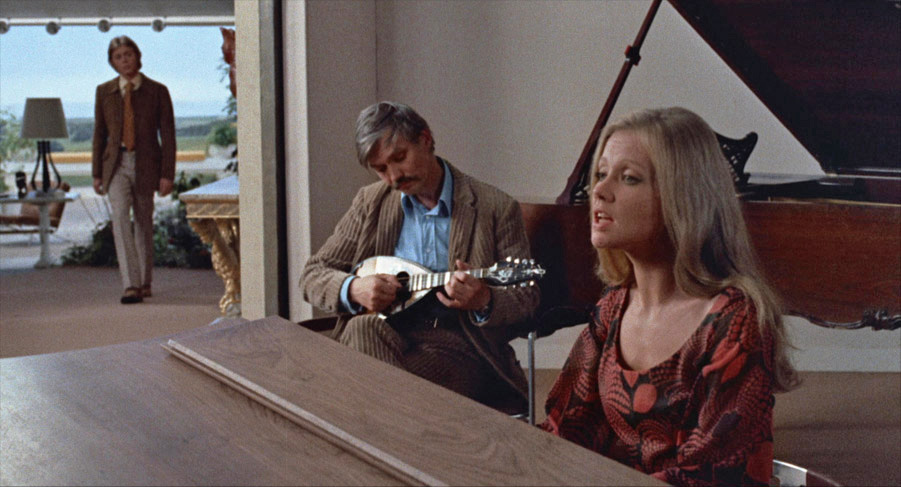
Thelma Connell's editing (one assumes accompanied by directorial intent) is extremely efficient and in some cases playful. As Mike describes what he would do with the house and the land, the editing places him in various different locations while he maintains an on-going conversation that would make little sense in reality. I really like cinema tricks like this that make you think you are watching something flowing and natural while if examined, you realise the scene is ridiculous… but it works so well. Either editor Connell got on very well with the normally irascible Bernard Herrmann or the composer just did something really quite lovely with the opening titles completely independently. Herrmann was a big fan of opening titles not least, one suspects, because it gave him the opportunity to lay out the film's theme and intent musically without any need for plot following. There is no denying that the orchestration and some sections of the score contain echoes of his classic Vertigo soundtrack. But the opening title of waves crashing on the shore and on rocks (from 2' 07" in) is almost perfectly in sync with Herrmann's stirring but mild string crescendos – each wave has its musical pulse. Once you notice the first few, you're almost disappointed at any breaking wave crash that's 'missed'. Hermann's on screen credit is accompanied by another, the solo keyboard artist, Howard Blake. Yes, it's The Snowman's Howard Blake whose Walking in the Air was so successful, he could subsequently write whatever he wanted without worrying about income. He plays the Moog synthesizer parts, a new instrument that was obviously exciting at the time. In the main title it comes in at 2' 35" and sits as well with Herrmann's orchestra's sublime sound as a horse does on another horse. As a rider-less horse bolts in the actual film at 1 hr, 14' 54", Hermann's cue at this point should leave no film fans wondering who's twirling the baton. You almost expect to see Janet Leigh looking in the rear-view mirror…
I have to say that a second viewing is more satisfying for picking up the more subtle clues the filmmakers have left us (an unintentional prescient remark – see the booklet review). New experiences on multiple viewings are always rewarding with any film. Endless Night poses a question on its original poster… "Only three people in a hundred guess the answer to Endless Night!" which nowadays make it sound like the death rate of the Coronavirus, the apparent reason that Daniel Craig's Bond swansong No Time To Die has abandoned its Easter opening and scuttled off to November when producers hope the threat of the virus will not put audiences off from turning up. My medical friends tell me it's a lot of fuss over very little (keeping your hands clean is enough to repel infection) but I always felt that if people got a bit too ambitious, Mother Nature would slap them back. I digress. Endless Night is a fun thriller with lots to enjoy even if the acting style is a bit dated and on the nail. Actor George Sanders had nothing to be ashamed of.
The 1.85:1 presentation looks pretty good though I did detect a few thin tramlines in some of the scenes. The booklet says that the original was mastered from a colour reversal intermediate (nice to see the old BBC training coming in handy there) which is a direct copy of the original negative with a few practical, chemical issues which I presume are easily if laboriously sorted in the digital realm. The contrast is solid and the colours vibrant and film grain is unnoticeable in normal viewing circumstances.
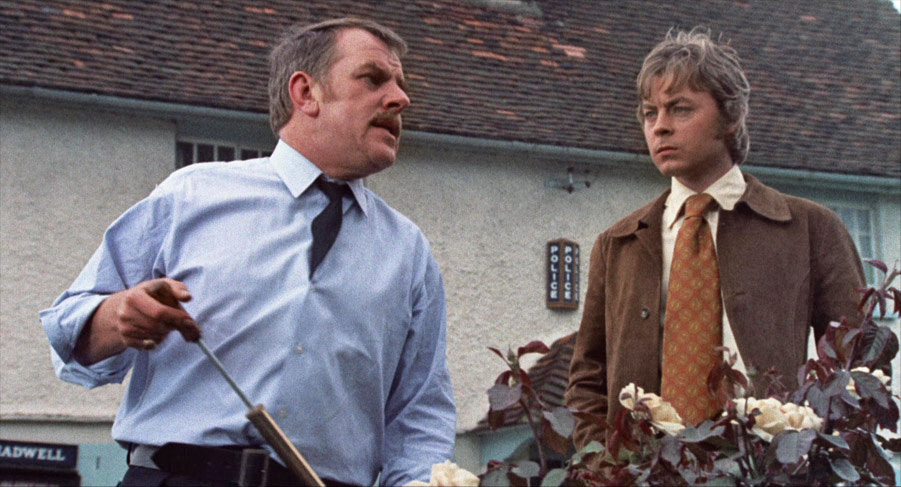
The remastered mono sound is in good condition with no clarity issues at all.
There are English subtitles and subtitles for the deaf and hard of hearing.
The BEHP (British Entertainment History Project) Interview with Sidney Gilliat (1990): archival audio recording, featuring the accomplished writer and director in conversation with Roy Fowler (1 hr. 34' 19") and Taffy Haines (5' 21")
Lots of gems in this main interview and as a distinct stereo image, there's a lot of traffic noise and general chair scraping from the left speaker from where the questions are asked. Hitchcock comes up a lot and he doesn't come out of the interview too well. Apparently he was quite happy to denigrate his writers by claiming 94 per cent credit for the scripts of his films, a claim which was published in the New Yorker magazine. There was a surreal exchange of mothers' letters defending their filmmaking sons over this egregious claim by the doyen of British cinema. David Lean asked J. Arthur Rank "What was a 'good' film?" and the great director was shocked to hear basically "films that make money." Knowing Gilliat was working when Lean, Hitchcock, Powell and Pressburger were all at the very zenith of their creative power gives a lovely frisson to the anecdotes. He mentioned that he learned so much more from bad directors. There was a lovely quote from a foreign film worker decrying the lack of integrity who said (add your own accent) "There's no inter-gritty. It's all com promise, com promise, com promise!"
The second interview, a little more muffled than the first, starts at 1 hr 34' 20" and only lasts 5' 21" but there's some great stories about the ciné-literacy of the French and how they knew more about Gilliat's work than Gilliat himself.
The John Player Lecture with Bernard Herrmann (1972): the renowned composer in conversation at London's National Film Theatre (52' 56")
Wow. I've not heard Herrmann before but I have to say he sounds exactly like I imagined. Right from the off, he underlines that this discussion not be mired in the past. It's not often the interviewer gets a slap on the wrist after the first question! There are clips we are obviously not seeing (or hearing) but despite this, Herrmann gives damn fine interview. He reminds us that music manipulates time. Orson Welles' innovative use of sound drove early audiences of Citizen Kane to chant "Sound! Sound! Sound!" thinking they were not hearing a music score that wasn't there. To the question, is a score meant to be heard, the great man says "No. I don't want to know there's a camera there or a composer there." Herrmann knocks down Pauline Kael's book on Kane pushing Welles out of the creative limelight. Kael didn't talk to him regarding her thesis on the landmark film. Nice to hear applause after Herrmann asserts Welles' authorship. The man also comes up with zingers from time to time. How about this one? "We have very precious, sophisticated composers who think it beneath them to write a film score but of course they're never asked." I'll finish with another after confirming that the studio did not keep a copy of Welles' original cut of The Magnificent Ambersons… "They were too busy giving Oscars to non-entities." Classic Herrmann.
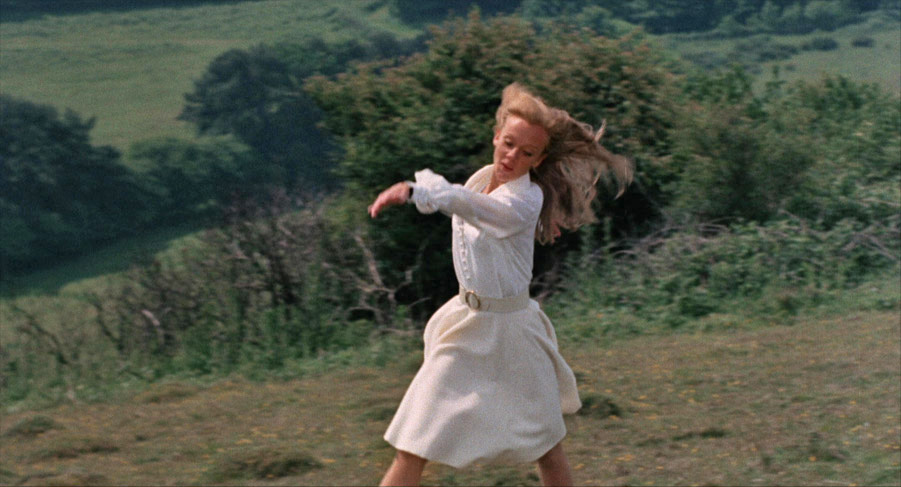
A Full House (2020): interview with celebrated actor Hayley Mills (7' 20")
Still beautiful and still laughing, this is a lovely, affectionate interview with an actress you imagine would be just so much fun to work with. Her memories of the film are amusing; George Sanders either pretended his memory was bad or he was having a laugh calling Hywel Bennett 'Margaret' during filming - well his hair was long for 1972, Mills observes. Britt Ekland's advice on drinking is invaluable (and it still works, says Mills!) If you don't want anyone to know you're drinking and to never put on weight, fresh grapefruit juice and vodka is the answer! Must give that a go. She emphasises how important Herrmann's score was. Although short, this extra is like a breath of fresh air. Hayley Mills is still eminently entertaining and funny.
Endless Notes (2020): composer and musician Howard Blake recalls working with Herrmann (12' 38")
Blake recalls his career (starting in the film industry as an NFT projectionist). Blake was the first to buy the 'Mini Moog' from Dr. Moog himself. To younger readers, the Moog was really the first synthesizer, the future in the shape of an electronic keyboard. Interestingly, Herrmann wanted a Theremin (that other worldly instrument you don't actually touch to get the sound) but the Moog was a good enough stand in to create that ethereal atmosphere. It seems Blake was a good friend to Herrmann and the story about De Palma's Sisters is a lovely counterpoint to the Bernard Herrmann as featured in Star Wars editor Paul Hirsch's memoir, A Long Time Ago in a Cutting Room Far, Far Away. Compare and contrast! This is a totally enlightening extra for just the connections between people you never realised were so closely connected. Just lovely.
Emotional Turbulence (2020): appreciation of Herrmann's late career by author and historian Neil Sinyard (16' 02")
Sinyard starts off reminding us that composer Bernard Herrmann was at something of a loss once he and Hitchcock broke up acrimoniously. Basing himself in England, Herrmann was soon to return to the States at the request of the 'Movie Brats' but while in the UK, worked on a number of films. Sinyard either researches voraciously just before he is filming or the man has been swimming in film encyclopaedias and by a wondrous osmosis taking on board the information therein. This is a revealing extra with Sinyard as ever delivering the goods.
Image gallery: on-set and promotional photography
This features 18 colour stills, 3 screens of 6 pages from the press pack and 4 international poster designs.
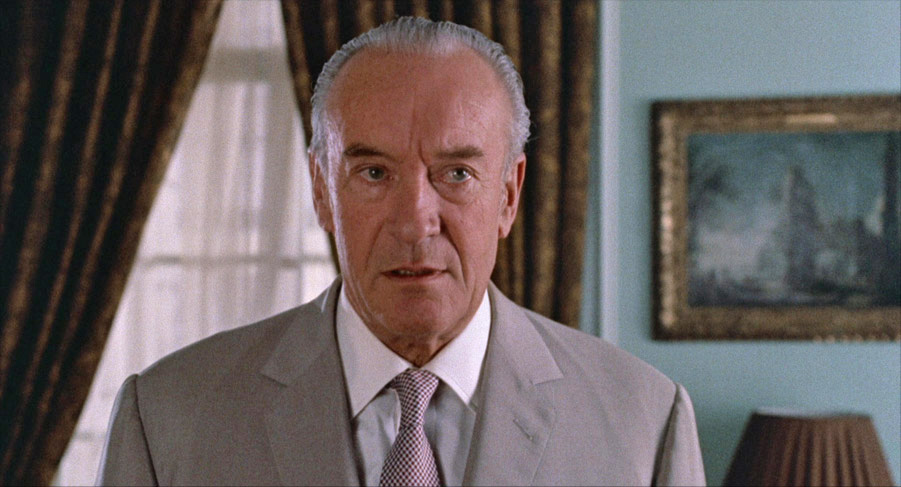
Original theatrical trailer (3' 13")
"Tell nobody, not even your best friend, the terrifying secret of Endless Night!" intones what sounds like Patrick Allen doing his best to chill our bones and only really making us smile with the datedness of the style. This 4:3 presented trailer is pretty grubby but it's effective enough on its own terms. It obviously worked for some markets but not all.
Limited edition exclusive 36-page booklet with a new essay by Anne Billson, Frank Launder and Sidney Gilliat on Endless Night, an archival interview with Gilliat, an overview of contemporary critical responses, and film credits
Wow! Coincidences, coincidences. In my summary I basically said what director Sidney Gilliat said of his own film, namely "I think the fault of Endless Night is that it's a better film the second time [you see it] than the first." He has a point. This quote is taken from the opening of Anne Billson's article on the background of the film's inception and production. The rest of the piece is informative and full of satisfying little facts that make you appreciate the work just that little bit more, which I hope is the point of the whole booklet. The Frank Launder and Sidney Gilliat interview (Launder and Gilliat on Endless Night) is again full of fascinating information even if it is just two pages long (four with photos and footnotes). It's nice to know the film enjoyed some success but not in the UK and the producers were unable to get a US distributor to take it on which I find baffling. Sidney Gilliat at Elstree is a 1993 extract from the BFI publication Projections conducted by filmmaker (and Emeric Pressburger's grandson), Kevin McDonald. This is an historical goldmine with an unlikely duo of a hunchbacked person of restricted growth (I think it's still acceptable to use the word 'dwarf') and a one legged man serving as Gilliat's introduction to the film industry. It's a very entertaining read. He started in the studios, met Hitchcock when he was a portly 28 year-old and got fired by criticising work by a contracted director at Elstree. Critical Response features the usual suspects showing the Monthly Film Bulletin mourning that Gilliat, Bennett and Mills were not Hitchcock, Cary Grant and Grace Kelly. Why were critics so mean-spirited? In the Observer, film critic George Melly (more famous to me as a jazz artist) mentioned loose ends left "dangling by reckless cutting." Not my take but there we are.
Endless Night is an atypical Agatha Christie story. If your murder mystery sensitivities are tickled by Orient Expresses and Egyptian rivers, with Poirots and Marples poring over clues and suspicious characters, then Endless Night will come as a fork in the Christie road. Essentially this movie is an entertaining mystery based primarily on its leading characters and you're guessing and second-guessing right the way through. For 1972 it was quite a departure for Christie fans and features an ending that is satisfying and somewhat ahead of its time. Well recommended.
|